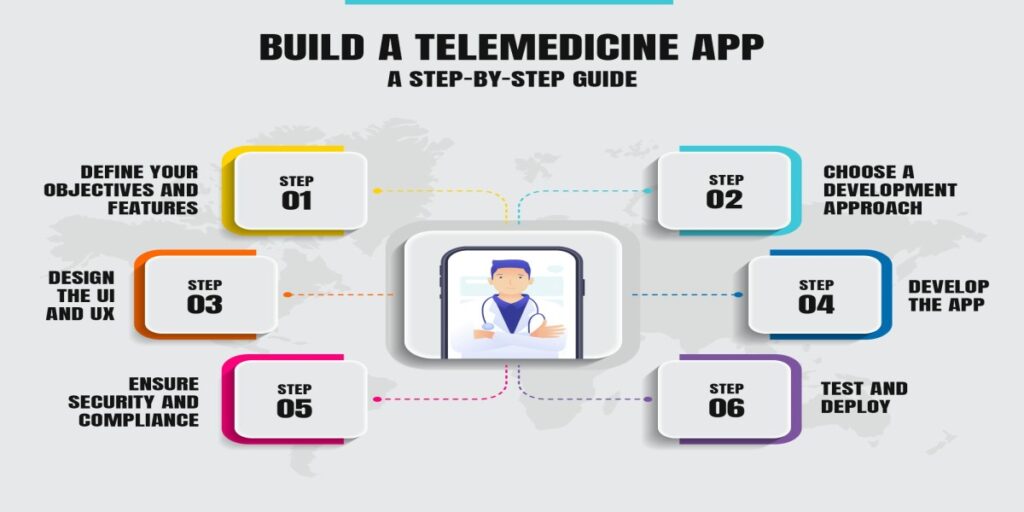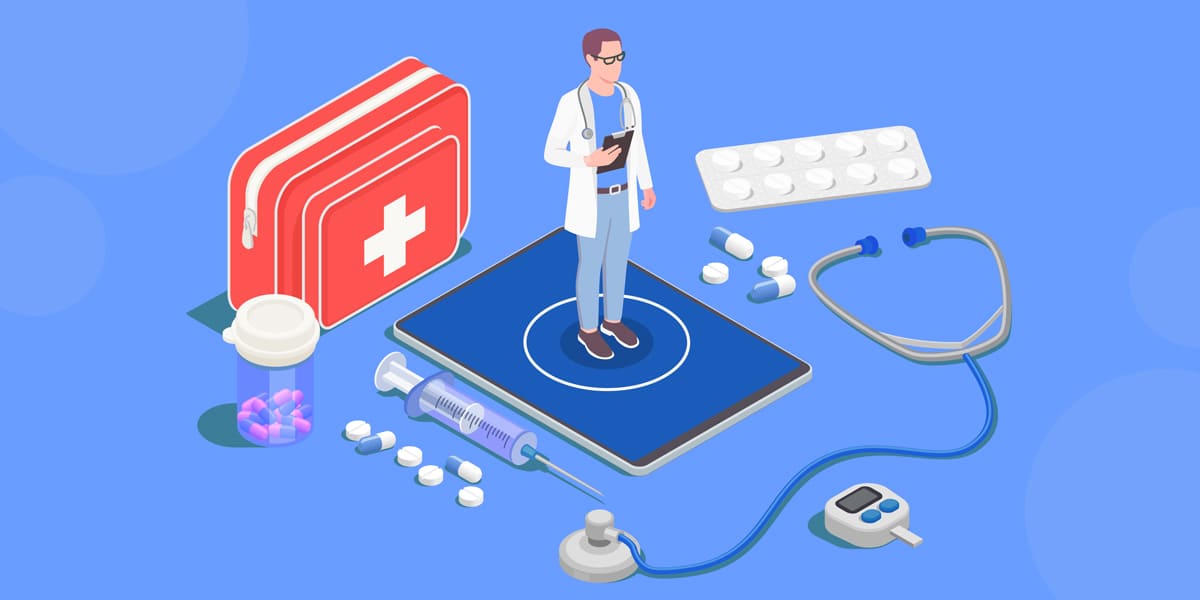In recent years, the healthcare industry has undergone a transformative shift with the advent of telemedicine apps. These platforms have revolutionized the way patients access medical care by providing remote consultations with healthcare professionals. One prominent player in this domain is “Doctor On Demand,” a telemedicine app that has gained widespread popularity for its convenient and accessible healthcare services. If you’re considering developing a similar app, it’s essential to understand the key components and statistical insights that contribute to the success of such platforms.
What is a Telemedicine Application?
A telemedicine app is a digital platform that facilitates remote medical consultations and healthcare services through the use of telecommunications technology. This type of app enables patients to connect with healthcare professionals, such as doctors, nurses, and specialists, without the need for in-person visits to a medical facility.
During the pandemic, telehealth utilization surged by more than 150%, underscoring the demand for virtual healthcare services.
The global telemedicine market is projected to grow significantly, with a CAGR of over 25% in the coming years.
Over 70% of patients express interest in using telemedicine for consultations, citing convenience and reduced travel time.
Understanding the Need for Telemedicine Apps:
The demand for telemedicine apps has surged due to several factors. The need for accessible and efficient healthcare, especially in remote areas, has prompted the development of these platforms. Additionally, the COVID-19 pandemic accelerated the adoption of telemedicine, as people sought ways to receive medical advice while minimizing in-person interactions. As a result, building an app like Doctor On Demand can bridge the gap between patients and healthcare providers, offering a convenient and safe way to access medical consultations.
Benefits of Telemedicine App Development: Creating an App Like Doctor On Demand
Building a telemedicine app similar to Doctor On Demand can bring forth a range of benefits that transform healthcare delivery. Here are the top seven advantages to consider:
1. Enhanced Healthcare Accessibility
Telemedicine applications overcome geographical limitations, ensuring that patients can access medical consultations regardless of their location. This level of accessibility is particularly beneficial for individuals residing in remote areas or those with mobility challenges, providing them with timely healthcare services.
2. Convenience and Time Savings
Creating an app like Doctor On Demand offers the convenience of scheduling virtual appointments at patients’ preferred times. This saves patients the hassle of traveling to a physical clinic, waiting in queues, and taking time off work. Additionally, healthcare providers can optimize their schedules for efficient consultations.
3. Immediate Medical Care
Telemedicine apps provide swift access to medical care, especially for non-emergency situations. Patients can receive medical advice and prescriptions promptly, preventing delays in diagnosis and treatment.
4. Cost-Efficiency
By eliminating the need for physical visits, telemedicine apps contribute to cost savings for patients and healthcare facilities alike. Patients save on transportation expenses, while healthcare providers can optimize resources by offering virtual consultations.
5. Continuity of Care and Follow-Up
Developing an app like Doctor On Demand allows for seamless continuity of care. Patients can easily schedule follow-up appointments, receive prescription renewals, and manage chronic conditions with regular virtual check-ins.
6. Specialist Access and Second Opinions
Telemedicine apps facilitate consultations with specialists who might be located far away. Patients can seek expert opinions, making it easier to manage complex medical issues and make informed decisions about their health.
7. Public Health and Safety
Telemedicine app development, modeled after Doctor On Demand, supports public health efforts. During pandemics or outbreaks, virtual consultations help minimize the spread of contagious diseases by reducing physical contact and crowded waiting rooms.
Building a Telemedicine App Like Doctor On Demand: A Step-by-Step Guide

Creating a telemedicine app similar to Doctor On Demand requires careful planning, design, development, and compliance with healthcare regulations. Here’s a step-by-step guide to help you build your own telemedicine app:
Step 1: Define Your Objectives and Features
Before you start developing the app, outline your goals and features. Determine whether the app will focus on video consultations, secure messaging, prescription management, appointment scheduling, etc. This step helps you create a clear roadmap for development.
Step 2: Choose a Development Approach
Decide whether you’ll build the app from scratch or use app development platforms like React Native or Flutter for faster development. Your choice will depend on your team’s skills, budget, and time constraints.
Step 3: Design the UI and UX
Create wireframes and prototypes of your app’s screens. Focus on intuitive navigation, a clean and user-friendly interface, and a seamless experience for both patients and healthcare providers. Design considerations should also include data security and privacy.
Step 4: Develop the App
Here’s a high-level overview of the development process:
Backend Development:Create a secure server to handle data storage, user authentication, appointment scheduling, and real-time communication.
Frontend Development: Develop the user interface for patients and healthcare providers. Implement features like video calls, messaging, appointment booking, and prescription management.
Integration:Integrate third-party tools if needed, such as video conferencing APIs or payment gateways.
Step 5: Ensure Security and Compliance
Given the sensitive nature of healthcare data, security is paramount. Implement encryption for data in transit and at rest, ensure compliance with health data regulations like HIPAA (if applicable), and regularly update the app to patch any security vulnerabilities.
Step 6: Test and Deploy
Thoroughly test your app on various devices and platforms to identify and fix any bugs or usability issues. Consider beta testing with a small group of users before the full launch. Once satisfied, publish your app on app stores like the Apple App Store and Google Play Store.
Building a telemedicine app like Doctor On Demand is a complex process that requires a multidisciplinary team, including developers, designers, healthcare experts, and legal advisors. By following this guide and prioritizing user experience, security, and compliance, you can create a valuable platform that transforms healthcare accessibility for patients and practitioners alike.
Monetization Strategies for Telemedicine Apps
1. Subscription Models
Offer different subscription tiers that provide varying levels of access to your telemedicine services. Users can choose plans based on their needs, with higher-tier subscriptions offering additional benefits such as unlimited consultations, priority scheduling, access to specialists, or premium customer support. This model encourages recurring revenue and builds a loyal user base.
2. Pay-Per-Consultation
Implement a pay-per-consultation model where users pay a fee for each virtual appointment with a healthcare professional. This straightforward approach ensures that users only pay for the services they use, making it attractive to occasional users or those seeking immediate medical attention.
3. Freemium Model
Provide a free version of your app with basic telemedicine services, and offer premium upgrades for more advanced features. The free version can include limited virtual visits or access to general practitioners, while the premium version might grant users access to specialized doctors, extended consultation times, or personalized health plans.
4. Telehealth Marketplace
Create a platform where users can browse and connect with a variety of healthcare providers. You can charge healthcare professionals a listing fee, a percentage of each consultation fee, or a combination of both. By offering a wide selection of providers, users can find the right healthcare specialist to meet their needs.
What is the Timeframe for Developing a Telemedicine App?
The timeframe for developing a telemedicine app can vary widely depending on the complexity of the app, features required, development approach, and team size. Generally, a basic telemedicine app with essential features like video consultations, appointment scheduling, and patient records might take around 3 to 6 months to develop.
More complex apps with advanced functionalities such as integration with medical devices, AI-driven diagnostics, and secure data storage could take 6 months to a year or more. Rapid development frameworks and pre-built components might expedite the process, but thorough testing and regulatory compliance are crucial considerations that can influence the timeline.
How Much Does it Cost to Build a Telemedicine App?
The cost of developing a telemedicine app can vary widely depending on factors such as the app’s complexity, features, development platform, design requirements, and the development team’s rates. A basic telemedicine app with fundamental features might cost anywhere from $5000 to $8000.
However, more sophisticated apps with advanced functionalities, integrations, and enhanced security measures could range from $100,000 to $300,000 or more. It’s important to note that ongoing maintenance, updates, and regulatory compliance might also contribute to the overall cost.
Conclusion
Undoubtedly, the healthcare sector is a highly promising industry poised for significant evolution in the times ahead. Innovations like telemedicine applications, for example, “doctor on demand,” are revolutionizing patient care by enabling precise evaluations, effective treatments, and accurate diagnoses even from distant locations.
If you are interested in venturing into the development of a telemedicine app, engaging on-demand app developers becomes imperative to craft an engaging platform. These professionals will provide comprehensive assistance throughout the development journey. Nonetheless, it’s crucial to evaluate their expertise, track record, and other pertinent factors before finalizing any contractual agreements.
